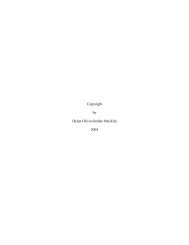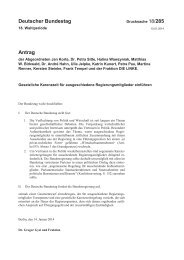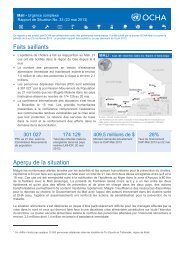saumel2012berlingardenproductscontamination
saumel2012berlingardenproductscontamination
saumel2012berlingardenproductscontamination
Create successful ePaper yourself
Turn your PDF publications into a flip-book with our unique Google optimized e-Paper software.
I. Säumel et al. / Environmental Pollution 165 (2012) 124e132 129<br />
[Zn] in mg/kg DW [Pb] in mg/kg DW<br />
40<br />
30<br />
20<br />
10<br />
0<br />
400<br />
300<br />
200<br />
100<br />
Leafy<br />
vegetables<br />
A<br />
a<br />
D<br />
a<br />
a<br />
a<br />
b<br />
a<br />
15<br />
10<br />
5<br />
0<br />
100<br />
80<br />
60<br />
40<br />
20<br />
B<br />
a<br />
E<br />
a<br />
Fruits<br />
a<br />
ab<br />
b<br />
b<br />
15<br />
10<br />
5<br />
0<br />
100<br />
80<br />
60<br />
40<br />
20<br />
Stem and Root<br />
vegetables<br />
b<br />
C<br />
a<br />
F<br />
a<br />
a<br />
a<br />
a<br />
0<br />
0<br />
0<br />
[Ni] in mg/kg DW [Cr] in mg/kg DW<br />
8<br />
6<br />
4<br />
2<br />
0<br />
4<br />
3<br />
2<br />
1<br />
G<br />
a<br />
J<br />
a<br />
a<br />
a<br />
a<br />
a<br />
2<br />
1<br />
0<br />
4<br />
3<br />
2<br />
1<br />
H<br />
a<br />
K<br />
a<br />
a<br />
a<br />
a<br />
a<br />
2<br />
1<br />
0<br />
4<br />
3<br />
2<br />
1<br />
I<br />
a<br />
L<br />
a<br />
ab<br />
ab<br />
b<br />
b<br />
0<br />
low medium high<br />
0<br />
low medium high<br />
Overall traffic burden<br />
0<br />
low medium high<br />
Fig. 3. Content of trace metals in the crop biomass in mg/kg biomass dry weight (DW) in relation to the overall traffic burden at each site. The boxplots indicate the 25th and 75th<br />
percentiles of the distribution. Lower case letters associated with the boxplots indicate significant differences in overall traffic burden (low, medium and high). The significance level<br />
is p < 0.05. For ANOVA results see Table 2.<br />
in previous studies (e.g., Kloke et al., 1984; Finster et al., 2004; Peris<br />
et al., 2007; UBA, 1995; Kachenko and Singh, 2006; Alexander et al.,<br />
2006; Murray et al., 2009 and 2011). The majority of these studies<br />
used controlled experimental approaches, which attempt to mimic<br />
‘real’ garden situations (e.g., Alexander et al., 2006; Murray et al.,<br />
2009, 2011) or took place on rural sites (Peris et al., 2007). Field<br />
surveys in urban areas are scarce but crucial to determine health<br />
risks of urban horticulture. The few existing studies did not focus<br />
on inner city neighbourhoods (e.g., Kloke et al., 1984; Schönhard<br />
and von Laar, 1992; UBA, 1995; Ge et al., 2002; Finster et al.,<br />
2004; Kachenko and Singh, 2006), where urban horticulture is<br />
currently booming (e.g., Meyer-Renschhausen and Holl, 2000;<br />
Viljoen, 2005; Mougeout, 2006; van Veenhuizen, 2006). Traffic<br />
related lead exposure has been reduced in recent years by the<br />
introduction of unleaded gasoline (Mielke et al., 2011). To our<br />
knowledge, our study is the first within the last two decades which<br />
focused explicitly on crops grown in inner city neighbourhoods and<br />
which related trace metal content of crop samples to traffic-related<br />
parameters.<br />
Surprisingly, vegetables planted in urban soil beds were less<br />
likely to have lead values above the critical values than vegetables<br />
planted in pots or beds that had been supplemented with<br />
commercial garden soil. This might result from the use of compost,<br />
which increases metal solubility (Murray et al., 2011), but more<br />
research is needed to reveal underlying causes as we could not<br />
analyse soil trace metal contents. Thus, the high variability of trace<br />
metal content in the biomass across different sites might have<br />
reflected the general heterogeneity of urban soils. Some of the<br />
extreme levels of trace metals might indicate additional point<br />
pollutant sources related to previous uses of the sites or from paint<br />
particles (Alloway, 2004). In Berlin, the patchiness of trace metal<br />
contamination is exacerbated by the haphazard distribution of<br />
debris resulting from bombing in World War II (Mekiffer et al.,<br />
2000; Alloway, 2004).<br />
In contrast to other studies (e.g., Ge et al., 2000; Finster et al.,<br />
2004; Alexander et al., 2006), we did not find that the vegetable<br />
type, i.e. fruit, root, stem or leafy vegetable, significantly affected<br />
the trace metal contents of the edible biomass. Some of the





